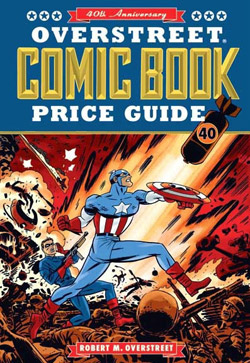 I was reading the Overstreet Price Guide the other day. I know what you’re thinking… nerd.. but hey, isn’t that why we are all here?. I starting thinking about the various “eras” in comic history. Overstreet has definitions now that talk of the “Pioneer Age” which references comics or early types of books with illustrations as the earliest forms of comics. This era runs from the 1500s to 1828. Now I am assuming that there is no definitive start date early on because really, it’s probably pretty unsure as to what specific dates exist for the creation of these books. A lot of these books are really more like illustrated books, which really is what a comic is. Comics are in fact a literary form that combines writing and drawing into one medium.
I was reading the Overstreet Price Guide the other day. I know what you’re thinking… nerd.. but hey, isn’t that why we are all here?. I starting thinking about the various “eras” in comic history. Overstreet has definitions now that talk of the “Pioneer Age” which references comics or early types of books with illustrations as the earliest forms of comics. This era runs from the 1500s to 1828. Now I am assuming that there is no definitive start date early on because really, it’s probably pretty unsure as to what specific dates exist for the creation of these books. A lot of these books are really more like illustrated books, which really is what a comic is. Comics are in fact a literary form that combines writing and drawing into one medium.
What gets interesting is the fact that Overstreet then coins the term “Victorian Age” for comics or illustrated books for the years 1646 to 1900. What makes this even more interesting is that once again there is some overlap over the years. The “Platinum Age” is then listed as 1883 -1938. So is a comic from say 1896 listed as Victorian or Platinum? I don’t want to belabour this point, because the number of examples out there really won’t warrant a long discussion because so few exist.
What then gets interesting of course are the definitions starting with 1938. Believe it or not, there are a few different suggestions about how to categorize comics from that point forward.
 While reading Shirrel Rhoades’ book on the history of comics, I found out that there are a few different schools of thought on this. By the way, Rhoades book A Complete History Of American Comic Books, is an excellent read, if not a little lacking of pictures and colour, on the history of American Comics. He is the former publisher of Marvel Comics and still works as an independent consultant on magazines and the comic industry.
While reading Shirrel Rhoades’ book on the history of comics, I found out that there are a few different schools of thought on this. By the way, Rhoades book A Complete History Of American Comic Books, is an excellent read, if not a little lacking of pictures and colour, on the history of American Comics. He is the former publisher of Marvel Comics and still works as an independent consultant on magazines and the comic industry.
Basically recounting his comments, there is a general school of thought which state the comics ages such as this:
- 1897-1937: Platinum Age
- 1938 – 1955: Golden Age
- 1956 – 1972: Silver Age
- 1973 – 1985: Bronze Age
- 1986 – Present: Modern Age
Although this is the general way that most people would categorize comics, there are new ways of thinking.
According to Rhoades, Ken Quattro writes in his article The New Ages: Rethinking Comic Book History, that there should be a new way of thinking about how to categorize comics. His eras are such as:
- 1938-1955: First Heroic Era
- 1955-1958: Code Era
- 1956-1986: Second Heroic Era
- 1986 – Present: Third Heroic Era
I don’t want to harp too much on Quattro’s ideas because really, without being too mean, I don’t think his ideas add anything to the categorizing of comics other than perhaps adding “heroic” to ages. And his “Code Era” could be considered, any of either “Post-Horror”, “Post-Crime”, or even just “Boring Era”.
Having said that, I think that any and all thought on comics is a good thing to keep the industry going.
I have to say that Overstreet really has come up with the best ideas with the catalyst to launch each of these eras or ‘ages’ with the exception of the Platinum Age.
- 1828 – 1892: Victorian Age
- 1883 – 1938: Platinum Age
- 1938 – 1945: Golden Age – Action Comics #1
- 1946 – 1956: Atom Age – Fear of the Bomb
- 1956 – 1971: Silver Age – Showcase #4
- 1971 – 1985: Bronze Age – Death of Gwen Stacy (Amazing Spidey #121)
- 1986 – 1992: Copper Age – DC’s Crisis on Infinite Earths
- 1992 – 1999: Chrome Age – Chrome Age – Image Comics Debuts
- 2000 – present: Modern Age – (proposed term for this article by Rhoades)
 This idea of these different eras really fit the ages and I have to agree with what Overstreet is trying to accomplish. It’s interesting to me that in an era where the internet rules the buying and selling options of the comic industry it seems that comic collectors still hold our ‘bible’, the Overstreet Price Guide, in high regard. Steve Geppi is still publishing this book every year, and despite the rising social networks like Facebook or Twitter, comic collectors still turn the pages of the Overstreet to help gauge their thoughts on what is going in the comic industry.
This idea of these different eras really fit the ages and I have to agree with what Overstreet is trying to accomplish. It’s interesting to me that in an era where the internet rules the buying and selling options of the comic industry it seems that comic collectors still hold our ‘bible’, the Overstreet Price Guide, in high regard. Steve Geppi is still publishing this book every year, and despite the rising social networks like Facebook or Twitter, comic collectors still turn the pages of the Overstreet to help gauge their thoughts on what is going in the comic industry.
Overstreet seems to simplify it enough to make it understandable for everyone but at the same time doesn’t dumb it down so much that the comics groupings become benign or irrelevant.
I have to say that in an era where being technologically sound, if not proficient, books like the Overstreet Price Guide still have their place in the comic industry.




I disagree with these defined eras. Detective Comics #1 is surely considered and Golden Age book but it was published in 1937. The Silver Age was triggered by the Comics Code which appeared in March 1955, Showcase 4 (1956) was the reaction from DC. The Bronze Age? Others site Conan #1 (10/70) or Green Lantern #76 (4/70) or the price change from 12 to 15 cents (1969) for the start of the Bronze Age. 1992 to 1995 should be the Foil Age and should end with the speculative comics crash. I wish someone would listen to me!
These are Overstreet’s ideas about when the particular ages start. I would definitely agree with you that Detective #1 should be considered Golden Age. However I still think that the Showcase 4 should be considered the first Silver Age. Although I think that there can be an argument that Showcase #1 and on can be considered Silver Age as well. As far as a Bronze age key starting point goes, I think the Death of Gwen Stacy isn’t enough of a turning point in comics. I think that the rise of Conan or even the price change would work equally as well for a starting point. As far as your Foil age goes, I think Chrome is actually a good term. It’s pretty flashy but no real substance.
I’m listening, Walt. Good points. Further thoughts: I think “Victorian” a misnomer and make little distinction between that and “Platinum” (really, an arbitrary name) for pre-“Golden Age” comics. For me, the GA runs 1937-55 from ‘Tec 1 to the advent of the Comics Code Authority — though I understand the argument that the GA really launches with the advent of Superman. I pay no heed to the “fine-tuning” of ’50s comics with “Atom Age” — which would better be called the “Crime & Horror Age” or the “Age of Diversity.” Better yet, fuhgeddaboudit. I like what you say about the CCA triggering the Silver Age, but really it killed the GA and comics floundered and meandered about until Showcase 4, which deserves the honor of starting point for the SA, which I suggest ends with the advent of “relevant comics” — 1970 works fine, including the GL/GA sea change and The Coming of Conan, and culminating in the (1971) Death of Gwen Stacy — which may deserve the honor of starting point for the Bronze Age; I consider the BA to run 1976-1985 (Star Wars to COIE). I used to hold that the SA ran until the first Superman movie (1977), but that’s a mite late… This whole “Copper Age” thing — >whatever<. I think of 1986-1992 (COIE to Image) as the Iron Age: industrious and in some ways innovative, but culminated in the gaudy speculation-and-crash of what I call The Gilded Age, 1992-1995 or 99. "Chrome" works but doesn't capture the downside. The Modern Age seems to saunter into play around 95 or 99; it's o.k. to leave a transitional margin on these "ages."
Very good point on the code and Showcase 4 Shazamzimzow.
shazamzimzow says:
October 25, 2010 at 9:05 pm
“I like what you say about the CCA triggering the Silver Age, but really it killed the GA and comics floundered and meandered about until Showcase 4, which deserves the honor of starting point for the SA,”
Most people use the term ‘Victorian Age’ to denote the reign of Queen Victoria in the UK. So you either have one or the other.
The one thing that rankles me with the Overstreet is the grading. They have Mint and Gem Mint. Something is either Mint or not – pure and simple. What they’ve done is given people the ability to sell comics that are VF at best as Mint, because Gem Mint is the best grade.
Get outta here!
Great point Daniel! This fascination with a new classification of Gem Mint has reached over to the sports cards market as well.
I’ve always viewed the ages as being repetitive and thematic. The Golden Age of Superhero Comics starts off with Action 1 in 1938 but the catalyst is really the earlier Detective Comics and New Fun issues. The tale end of the Golden Age is the Atomic Age, a buffer era characterized most prominently by EC Comics and culminating in the arrival of the comics code. 1938-1952(6).
The Silver Age of Superhero Comics debuts in 1956 the arrival of the Flash in Showcase, but there are precursor events that lead to it’s arrival in the earlier part of the decade. Marvel arrives 6 years into the Silver Age and galvanizes even more that we are in a new era of comics superheroes. Silver has hit it’s peak in the mid-1960’s but the times are-a-changing and by 1970 the comics are quite different. 1956-1970.
The Bronze Age of Superhero Comics arrives in 1970 with Conan 1 and GL/GA 76 (and to a certain extent the arrival of Man-Bat earlier that year) as Conan and Green Arrow are anti-establishment anti-heroes. Marvel’s price jump and line expansion, as well as Kirby leaving Marvel for DC are all important catalysts. But the key characteristics launching Bronze are the addressing of social/adult themes and the arrival of anti-heroes in feature roles, including the return of horror themes that were banished with the arrival of the code in the mid-1950’s. The rest of bronze is characterized by the rise of the direct market system and the rise to prominence of the X-Men, particularly Wolverine.
The Copper Age of Superhero Comics is where I get contentious and disagree with Overstreet. I think Copper runs from 1984-1998. I do agree that the arrival of the event comic is the key launching point — Secret Wars at Marvel and Crisis on Infinite Earths at DC, it leads to an overwhelming “event” mentality which characterizes the next 14 years of comics and nearly kills us — this is where I disagree with Overstreet in that I see the arrival of Image, Valiant, etc. as being a distinct, new era. I see them as being a part of the previous era and not one unto itself. We don’t declare the Silver Age as having ended with the arrival of Marvel Comics’ Fantastic Four #1 six years after Showcase 4. FF1 is the direct result of the path that DC started on with reviving the Flash, GL and the Justice Society (as the Justice League). The success of those books fired the greed in Marty Goodman and he got his nephew Stan on creating his own line of superheroes. Likewise, the demand for event comics – big selling number ones with gimmick hooks, relaunching superheroes, killing them, mini-series, new universes, special covers, etc. all boil down to Secret Wars and Crisis. The event comics and the superstar artist cult lead to the rise of the Image gang after big successes with Marvel and DC. If one looks closely, the same amount of time elapses (approx. 14 years) as Bronze until the Copper Age is really kaput and the superheroes are moving in a different direction (one more story-driven than anything else). Marvel has filed for bankruptcy protection, sales are down, companies out of business, the image partners have split, etc.
The next age, Modern for now, begins around 1998/9 and is on the verge of wrapping up. The key events are (1) DC’s purchase of Wildstorm – essentially bringing Jim Lee into their company – while Wildstorm limped along, Lee’s presence at DC changed the direction of their company, as did (2) Grant Morrison, particularly with JLA recreation of the DCU – JLA would beget JSA which in turn brought Geoff Johns into the company, further cementing the changes in attitude at DC. (3) Marvel outsources some titles like Daredevil to the Marvel Knights imprint under the direction of Joe Quesada, Quesada’s successes would revitalize those titles enough that Marvel appoint him EIC and his direction, especially with the launch of the Ultimate line in 2000/1, bring the company back into profitability and eventual sale to Disney. Finally, Warren Ellis debuts Planetary and the Authority in 1999, further changing the way we look at superhero comics and directly inspiring Mark Millar to begin his reign of terror.
So here we are in 2010, and we’re reaching the end of an era. What’s next? Who knows. But burnout is reaching levels lower than they were in 1996-1997, Quesada’s Marvel has been sold to Disney, yet remains directionless despite coming out of the decade with hugely successful movie franchises. DC is now run by Jim Lee, Geoff Johns and Grant Morrison (and Dan Didio), but people are burning out on their books as well.
“I don’t want to harp too much on Quattro’s ideas because really, without being too mean, I don’t think his ideas add anything to the categorizing of comics other than perhaps adding “heroic” to ages.”
Hi Chris,
I’m glad you weren’t too mean to me.
I do, however, believe you’ve given a rather distorted representation of what I wrote. Since you kindly supplied a link to my online article, I won’t take up space rewriting it here. But if you take the time to re-read it, you will find that the “heroic” term I applied to some of the eras actually came from Dr. Jerry Bails, who first used them in the mid-Sixties. Dr. Bails was also instrumental in helping me formulate the outline for my article. We corresponded frequently during its writing and I believe you will find that there is far more to it than the changing of a few terms.
In brief: the terms I used were descriptive of the actual trend or overriding influence of a given time period of comic book history. Terms such as “Copper Age”, “Chrome Age”, etc., are meaningless. So too are some of the arbitrary milestones that delineate the various Ages. Again, I go into much more detail in my article if you care to re-read it.
I notice from your bio that you teach Sequential Art History. You may be interested in checking out my blog, The Comics Detective. It’s devoted to comic history and if you care to check it out, here is a link to a recent post of mine that may be of interest: http://thecomicsdetective.blogspot.com/2010/07/dc-vs-victor-fox-testimony-of-will.html
Take care, Chris.
Ken
Hi Ken!
Thanks for replying. And, I’m glad you weren’t too mean to me either.
I agree with your ideas that the terms used for defining the ages thus far are pretty arbitrary. Other than the fact that socially speaking, we think of a “Golden” era being an exciting and creative time period that generally pushes whatever medium to a new height.
Having said that, I will definitely check out your blog as I am always interested in reading what other people say about comic history.
Thanks, Ken!
Chris